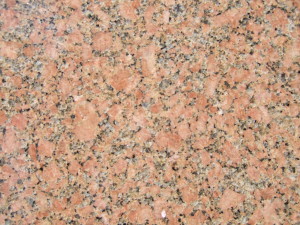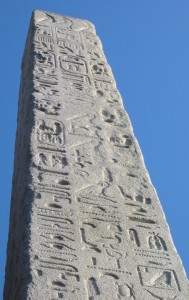Granite, has been in use over the decades, maybe even centuries. The is evidence of granite in use during pre-historic period as well as the popular modern era use in architecture and construction. Here we analyse what granite is, its composition, and physical properties, and examine the few different uses of granite.
 Granite is a common type of felsic intrusive igneous rock that is granular and phaneritic in texture. The word “granite” comes from the Latin granum, a grain, in reference to the coarse-grained structure of such a crystalline rock. The term granite also applies to a group of intrusive igneous rocks with similar textures and slight variations on composition and origin. These rocks mainly consist of feldspar, quartz, mica, and amphibole minerals, which form interlocking, somewhat equigranular matrix of feldspar and quartz with scattered darker biotite mica and amphibole (often hornblende) peppering the lighter color minerals. Granites can be predominantly white, pink, or gray in color, depending on their mineralogy. By definition, granite is an igneous rock with at least 20% quartz and up to 65% alkali feldspar by volume.
Granite is a common type of felsic intrusive igneous rock that is granular and phaneritic in texture. The word “granite” comes from the Latin granum, a grain, in reference to the coarse-grained structure of such a crystalline rock. The term granite also applies to a group of intrusive igneous rocks with similar textures and slight variations on composition and origin. These rocks mainly consist of feldspar, quartz, mica, and amphibole minerals, which form interlocking, somewhat equigranular matrix of feldspar and quartz with scattered darker biotite mica and amphibole (often hornblende) peppering the lighter color minerals. Granites can be predominantly white, pink, or gray in color, depending on their mineralogy. By definition, granite is an igneous rock with at least 20% quartz and up to 65% alkali feldspar by volume.
Granite is nearly always massive (lacking any internal structures), hard and tough, and therefore it has gained widespread use throughout human history, and more recently as a construction stone. The average density of granite is between 2.65 and 2.75 g/cm3, Melting temperature of dry granite at ambient pressure is or 1215–1260 °C (2219–2300 °F); it is strongly reduced in the presence of water, down to 650 °C at a few kBar pressure. Granite has poor primary permeability, but strong secondary permeability.
Composition of granite
Here is the chemical compostion of granite. This is the worldwide average of the composition based on 2458 analyses, as a percentage of weight.

Silica (SiO2) – 72.04%
Alumina (Al2O3) – 72.04%
K2O – 4.12%
Na2O – 3.69%
CaO – 1.82%
FeO – 1.68%
Fe2O3 – 1.22%
MgO – 0.71%
TiO2 – 0.30%
P2O5 – 0.12%
MnO – 0.05%
Uses of Granite
The Red Pyramid of Egypt, named for the light crimson hue of its exposed granite surfaces, is the third largest of Egyptian pyramids. Menkaure’s Pyramid, likely dating to the same era, was constructed of limestone and granite blocks. The Great Pyramid of Giza contains a huge granite sarcophagus fashioned of “Red Aswan Granite”. The mostly ruined Black Pyramid dating from the reign of Amenemhat III once had a polished granite pyramidion or capstone, now on display in the main hall of the Egyptian Museum in Cairo. Other uses in Ancient Egypt include columns, door lintels, sills, jambs, and wall and floor veneer. How the Egyptians worked the solid granite is still a matter of debate. Dr. Patrick Hunt[23] has postulated that the Egyptians used emery shown to have higher hardness on the Mohs scale.
Rajaraja Chola I of the Chola Dynasty in South India built the world’s first temple entirely of granite in the 11th century AD in Tanjore, India. The Brihadeeswarar Temple dedicated to Lord Shiva was built in 1010. The massive Gopuram (ornate, upper section of shrine) is believed to have a mass of around 81 tonnes. It was the tallest temple in south India.
Buildings
 In some areas, granite is used for gravestones and memorials. Granite is a hard stone and requires skill to carve by hand. Until the early 18th century, in the Western world, granite could only be carved by hand tools with generally poor results.
In some areas, granite is used for gravestones and memorials. Granite is a hard stone and requires skill to carve by hand. Until the early 18th century, in the Western world, granite could only be carved by hand tools with generally poor results.
A key breakthrough was the invention of steam-powered cutting and dressing tools by Alexander MacDonald of Aberdeen, inspired by seeing ancient Egyptian granite carvings. In 1832, the first polished tombstone of Aberdeen granite to be erected in an English cemetery was installed at Kensal Green cemetery. It caused a sensation in the London monumental trade and for some years all polished granite ordered came from MacDonalds.
Working with the sculptor William Leslie, and later Sidney Field, granite memorials became a major status symbol in Victorian Britain. The royal sarcophagus at Frogmore was probably the pinnacle of its work, and at 30 tons one of the largest. It was not until the 1880s that rival machinery and works could compete with the MacDonald works.
Modern methods of carving include using computer-controlled rotary bits and sandblasting over a rubber stencil. Leaving the letters, numbers and emblems exposed on the stone, the blaster can create virtually any kind of artwork or epitaph.
Granite has been extensively used as a dimension stone and as flooring tiles in public and commercial buildings and monuments. Aberdeen in Scotland, which is constructed principally from local granite, is known as “The Granite City”. Because of its abundance, granite was commonly used to build foundations for homes in New England.
The Granite Railway, America’s first railroad, was built to haul the stone from the quarries in Quincy, Massachusetts, to the Neponset River in the 1820s. With increasing amounts of acid rain in parts of the world, granite has begun to supplant marble as a monument material, since it is much more durable. Polished granite is also a popular choice for kitchen countertops due to its high durability and aesthetic qualities. In building and for countertops, the term “granite” is often applied to all igneous rocks with large crystals, and not specifically to those with a granitic composition.
Engineering
Engineers have traditionally used polished granite surface plates to establish a plane of reference, since they are relatively impervious and inflexible. Sandblasted concrete with a heavy aggregate content has an appearance similar to rough granite, and is often used as a substitute when use of the real stone is impractical. A most unusual use of granite was in the construction of the rails for the Haytor Granite Tramway, Devon, England, in 1820. Granite block is usually processed into slabs and after can be cut and shaped by a cutting center. Granite tables are used extensively as a base for optical instruments due to the stone’s rigidity, high dimensional stability and excellent vibration characteristics.
Other uses
Curling stones are traditionally fashioned of Ailsa Craig granite. The first stones were made in the 1750s, the original source being Ailsa Craig in Scotland. Because of the particular rarity, the best stones can cost as much as US$1,500. Between 60 and 70 percent of the stones used today are made from Ailsa Craig granite, although the island is now a wildlife reserve and is still used for quarrying under license.

